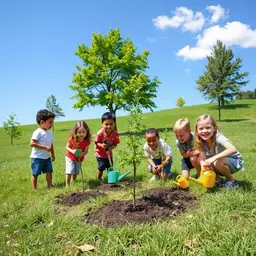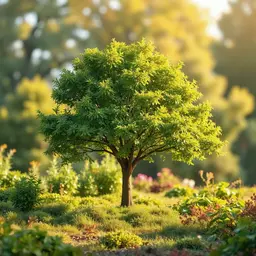Choosing Native Trees for Planting

Did you know that planting just one native tree can create a thriving habitat for local wildlife and help combat climate change? The significance of native trees goes far beyond aesthetics; they are vital to preserving our ecosystems. By understanding their benefits and how to care for them, we can make meaningful contributions to our environment.
What You Will Learn
- Native trees foster biodiversity by providing essential resources for local wildlife, including food, shelter, and nesting sites.
- Choosing native trees requires less maintenance, as they are adapted to local conditions, leading to lower water and fertilizer needs.
- Native trees play a significant role in carbon sequestration, absorbing carbon dioxide and helping mitigate climate change.
- Implementing proper practices such as mulching, minimal pruning, and encouraging beneficial insects enhances the health and longevity of native trees.
- Participating in community conservation efforts and educating others can amplify the impact of your eco-friendly planting initiatives.
Ecological Benefits and Advantages of Native Trees
Understanding the key benefits that native trees offer compared to non-native species can help in making informed planting decisions.
Ecological Benefits
- Provides habitats for local birds and mammals.
- Encourages pollinators like bees and butterflies.
- Improves soil health and reduces erosion.
Advantages Over Non-Native Plants
- Lower water requirements.
- Fewer pest problems due to natural resistance.
- Less need for fertilizers or soil amendments.
Carbon Sequestration Benefits
- Store more carbon due to longevity and size.
- Enhance soil carbon storage through deep root systems.
- Maintain balanced ecosystems, vital for climate resilience.
Maintenance Tips
- Deep soak weekly for newly planted trees.
- Apply a layer of mulch to retain moisture.
- Prune only to remove dead or damaged branches.
Understanding the Importance of Native Trees in Eco-Friendly Planting
When we think about trees, it's essential to recognize the significant role that native trees play in our ecosystems. These trees are perfectly adapted to their local environments, helping to create a thriving habitat for wildlife. By planting native trees, we not only support biodiversity but also strengthen the overall health of our local ecosystems. Using resources such as the University of Georgia Extension's guide to native plants can help you identify the right species for your region. Have you ever observed a hummingbird visiting a native flower? This is just one way that native trees attract local wildlife!
Ecological Benefits of Choosing Native Trees
One of the most beautiful aspects of native trees is their ability to nurture local wildlife. They provide essential resources such as food, shelter, and nesting sites. For example, by planting a native oak or maple, you can attract a variety of birds and insects that rely on these trees for their survival. This support for the food web enhances the resilience of our ecosystems and promotes biodiversity.
- Native trees offer habitats for local birds and mammals.
- They encourage pollinators like bees and butterflies.
- These trees can help improve soil health and reduce erosion.
Additionally, native trees often require fewer resources, such as water and fertilizers, making them an excellent choice for eco-friendly planting! By selecting these trees, we can contribute to a healthier planet while reducing our environmental footprint.
Advantages Over Non-Native Plants
When it comes to planting, native trees have several advantages over non-native varieties. They are typically low maintenance, which means less time and money spent on care! For instance, native trees are adapted to local soil types and climate conditions, allowing them to thrive without excessive watering or chemical treatments. This makes them an ideal choice for eco-friendly gardening.
- Lower water requirements compared to non-native species.
- Fewer pest problems due to natural resistance.
- Less need for fertilizers or soil amendments.
By choosing native trees, you can spend more time enjoying your garden and less time worrying about upkeep. It’s a win-win situation that benefits both you and the environment!
Native Tree Benefits for Carbon Sequestration
Native trees also play a crucial role in mitigating climate change through carbon sequestration. As they grow, these trees absorb carbon dioxide from the atmosphere and store it in their biomass and soil. This process helps to reduce the greenhouse gases that contribute to global warming. Isn't it inspiring to think that planting a tree can help combat climate change?
- Native trees store more carbon due to their longevity and size.
- Their deep root systems enhance soil carbon storage.
- They help maintain a balanced ecosystem, which is vital for climate resilience.
By incorporating native trees into our landscapes, we can take meaningful steps toward a greener future. Each tree planted is a step toward reducing our carbon footprint, making every planting effort so much more impactful!
Frequently Asked Questions About Native Trees
- What are the main benefits of planting native trees?
- Native trees support local wildlife, require less maintenance, help with carbon sequestration, and enhance ecosystem health.
- Why are native trees better than non-native trees?
- Native trees are adapted to local conditions, require less water and fertilizer, and have fewer pest problems.
- How do native trees help with climate change?
- Native trees absorb carbon dioxide from the atmosphere and store it in their biomass and soil, reducing greenhouse gases.
- What are some essential maintenance tips for native trees?
- Essential maintenance includes regular watering, mulching, and minimal pruning.
- How can I get involved in native tree conservation?
- You can participate in local conservation efforts, educate others about the benefits of native trees, and support native plant societies.
Essential Steps for Selecting Native Trees
Now that we understand the benefits of native trees, how do we go about selecting the right ones for our spaces? It’s important to consider several factors to ensure the best fit for your planting needs. Resources like Pollinator.org guides can help you select trees that support specific wildlife such as bees and butterflies.
Pro Tip
When selecting native trees for your garden, consider choosing a variety of species that bloom at different times throughout the year. This approach not only enhances the visual appeal of your landscape but also provides a continuous food source for local wildlife, supporting biodiversity year-round. It’s a simple yet effective way to create a thriving ecosystem right in your backyard!
Long-Term Care for Native Trees
Taking care of our native trees is just as important as planting them! With the right attention and love, these trees can thrive for decades, contributing to our ecosystems in remarkable ways. At Timber & Thrive, I believe that long-term care practices can transform our landscapes and support our environmental goals. Let’s dive into some essential maintenance tips to keep your native trees healthy and vibrant. You can also refer to resources like Garden for Wildlife's guide to native plant gardening for additional insights.
Maintenance Tips for Healthy Growth
To ensure that your native trees grow strong and healthy, follow these straightforward maintenance practices:
- Watering: Newly planted trees often need regular watering, especially during dry spells. Aim for a deep soak once a week.
- Mulching: Apply a layer of mulch around the base of the tree. This helps retain moisture, suppress weeds, and regulate soil temperature.
- Minimal Pruning: Only prune to remove dead or damaged branches. Over-pruning can stress the tree and hinder its growth.
These simple steps create a nurturing environment for your trees, allowing them to reach their full potential. Remember, the goal is to work with nature, not against it!
Pest Control Strategies for Native Trees
Managing pests doesn’t have to be a chore! Here are some natural strategies to keep your native trees healthy while promoting ecological balance:
- Encourage Beneficial Insects: Ladybugs and lacewings are great allies in pest control. They feed on common pests like aphids.
- Neem Oil: This natural pesticide is derived from the seeds of the neem tree. It can deter a variety of pests while being safe for beneficial insects.
- Regular Inspections: Check your trees periodically for signs of pests or disease, allowing you to address issues before they escalate.
By adopting these eco-friendly pest control methods, you can protect your trees while maintaining a harmonious environment.
Conservation Practices for Sustaining Native Trees
To ensure the longevity and health of your native trees, incorporate these conservation practices into your routine:
- Protect Natural Habitats: Avoid disturbing the natural surroundings where your trees grow. This helps preserve the local ecosystem.
- Participate in Local Conservation Efforts: Get involved with community initiatives focused on preserving native flora and fauna.
- Educate Others: Share your knowledge about the benefits of native trees with friends and family. Together, we can create a ripple effect of awareness and action.
As a steward of nature, your efforts in conservation can make a significant impact. Let’s work together to ensure our native trees flourish in their natural habitats!
Final Thoughts on Eco-Friendly Native Tree Planting
Summary of Key Recommendations for Successful Planting
In summary, choosing and caring for native trees is a rewarding venture that benefits our environment and communities. By focusing on proper maintenance, pest control, and conservation practices, you can create a haven for these trees. Remember, every action counts, and your commitment to sustainable gardening will resonate for generations to come!
Call to Action: Get Involved in Eco-Friendly Planting
What’s your next step? Explore local native tree options at Timber & Thrive! Join community planting initiatives and witness the positive changes in your neighborhood. Together, let’s take action for our planet!
Engaging with Local Native Plant Societies
Connecting with local native plant societies can provide invaluable support and resources. These organizations often offer workshops, educational events, and networking opportunities that deepen your understanding of native tree care. So, seek out these communities and enrich your eco-friendly journey!
Recap of Key Points
Here is a quick recap of the important points discussed in the article:
- Native trees support biodiversity by providing habitats for local wildlife and enhancing ecosystem health.
- They require fewer resources, such as water and fertilizers, making them an eco-friendly planting choice.
- Native trees are better suited to local conditions, leading to lower maintenance and care costs.
- Planting native trees contributes to carbon sequestration, helping to mitigate climate change.
- Regular maintenance, including proper watering, mulching, and minimal pruning, is essential for their long-term health.
- Adopting eco-friendly pest control strategies and participating in conservation efforts can further sustain native trees.
- Engaging with local native plant societies can provide resources and community support for eco-friendly planting initiatives.



